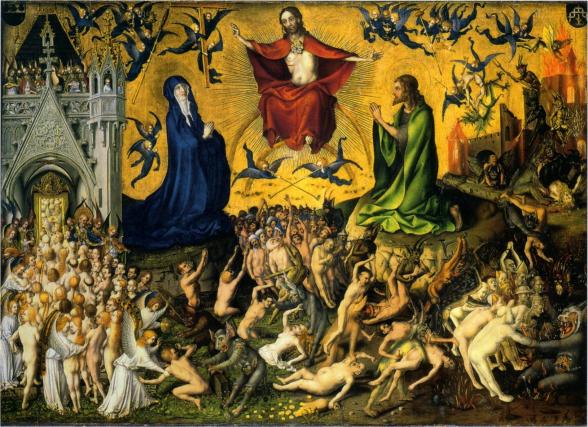Last Judgment, Stefan Lochner, 1435, Wallraf-Richartz-Museum, Cologne, Germany
Jesus said to the crowds:
“Everything that the Father gives me will come to me,
and I will not reject anyone who comes to me,
because I came down from heaven not to do my own will
but the will of the one who sent me.
And this is the will of the one who sent me,
that I should not lose anything of what he gave me,
but that I should raise it on the last day.
For this is the will of my Father,
that everyone who sees the Son and believes in him
may have eternal life,
and I shall raise him on the last day.”
John 6:37-40
From Catholic Online:
“All Souls Day is a holy day set aside for honoring the dead. The day is primarily celebrated in the Catholic Church, but it is also celebrated in the Eastern Orthodox Church and a few other denominations of Christianity. The Anglican church is the largest protestant church to celebrate the holy day. Most protestant denominations do not recognize the holiday and disagree with the theology behind it.
According to Catholic belief, the soul of a person who dies can go to one of three places. The first is heaven, where a person who dies in a state of perfect grace and communion with God goes. The second is hell, where those who die in a state of mortal sin are naturally condemned by their choice. The intermediate option is purgatory, which is thought to be where most people, free of mortal sin, but still in a state of lesser (venial) sin, must go.
Purgatory is necessary so that souls can be cleansed and perfected before they enter into heaven. There is scriptural basis for this belief. The primary reference is in 2 Maccabees, 12:26 and 12:32. “Turning to supplication, they prayed that the sinful deed might be fully blotted out… Thus made atonement for the dead that they might be free from sin.”
Additional references are found in Zechariah, Sirach, and the Gospel of Matthew. Jewish tradition also reinforces this belief as well as the tradition and teaching of the Church, which has been affirmed throughout history.
Consistent with these teachings and traditions, Catholics believe that through the prayers of the faithful on Earth, the dead are cleansed of their sins so they may enter into heaven.
The belief in purgatory has not been without controversy. Certainly, some flagrant abuses of the doctrine were used to raise money for the Church during the renaissance. Famously, Martin Luther argued with the monk, Johan Tetzel, over the sale of indulgences. Indulgences were sold as spiritual pardons to the poor and applied to the souls of the dead (or the living) to get people into heaven. The abuse of indulgences and the blatant, sometimes fraudulent practice of selling indulgences for money, led to Luther’s protest.
When Martin Luther translated the Bible into German, he omitted the seven books of the canon which refer to prayers for the dead. He then introduced the heretical belief that people are simply saved, or not, and argued that there is no need to pray for the dead to get them into heaven.
The Church reeled from Luther’s accusation, and reformed its practice of selling indulgences. However, it reemphasized the Biblical and traditional practice of praying for the departed and the importance of such prayers.
All Souls Day is celebrated in much of the western world on November 2. Other rites have their own celebrations. The Eastern Orthodox Church has several such days throughout the year, mostly on Saturdays. All Souls Day is not a holy day of obligation. It should not be confused with All Saints’ Day, which is a holy day of obligation.
Many cultures also mark the day differently. In North America, Americans may say extra prayers or light candles for the departed. In parts of Latin America, families visit the graves of their ancestors and sometimes leave food offerings for the departed.”



